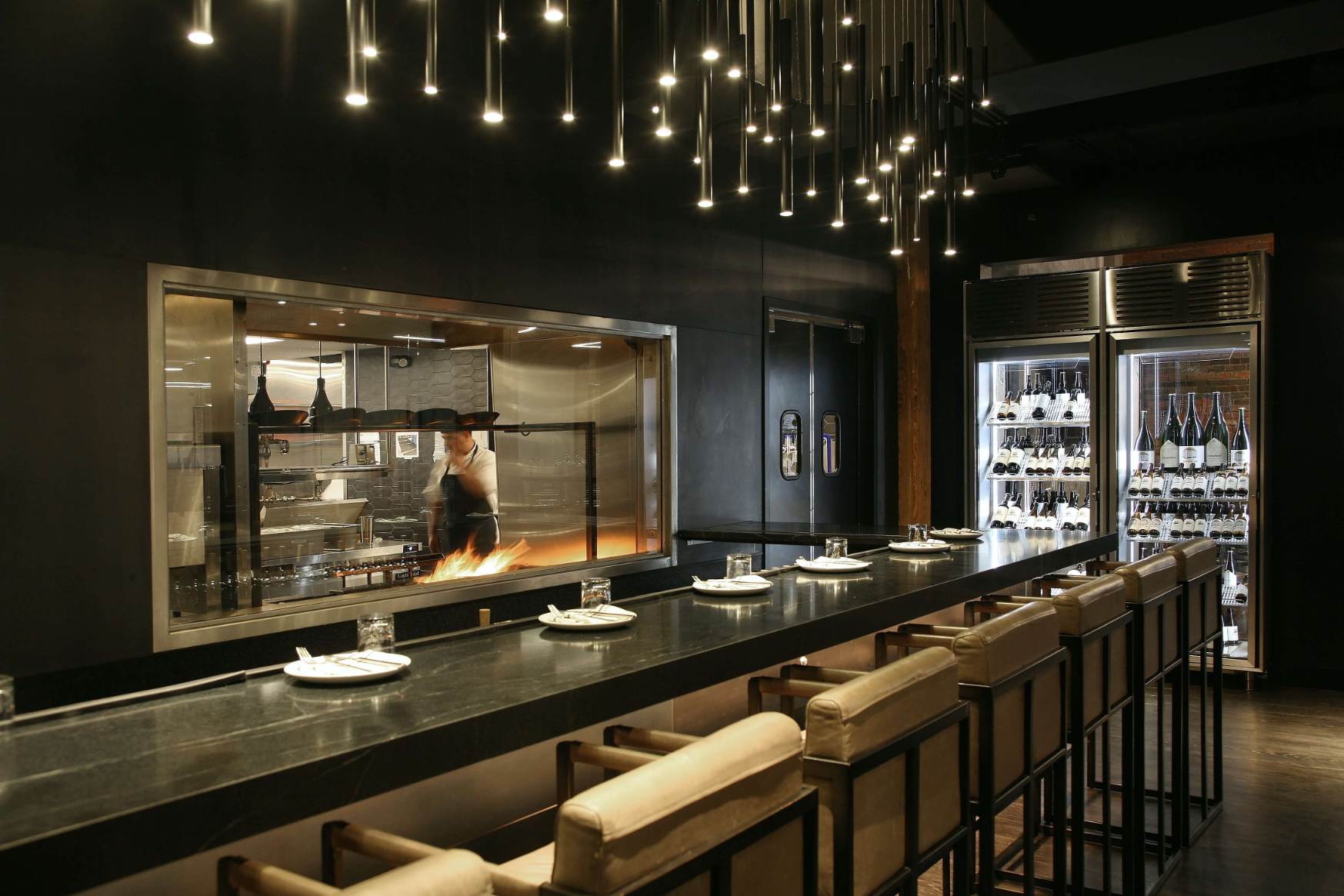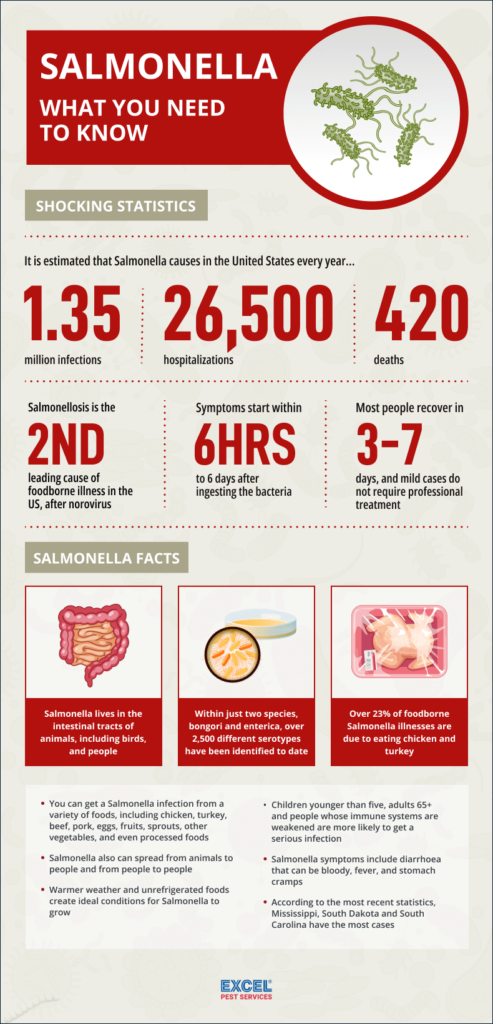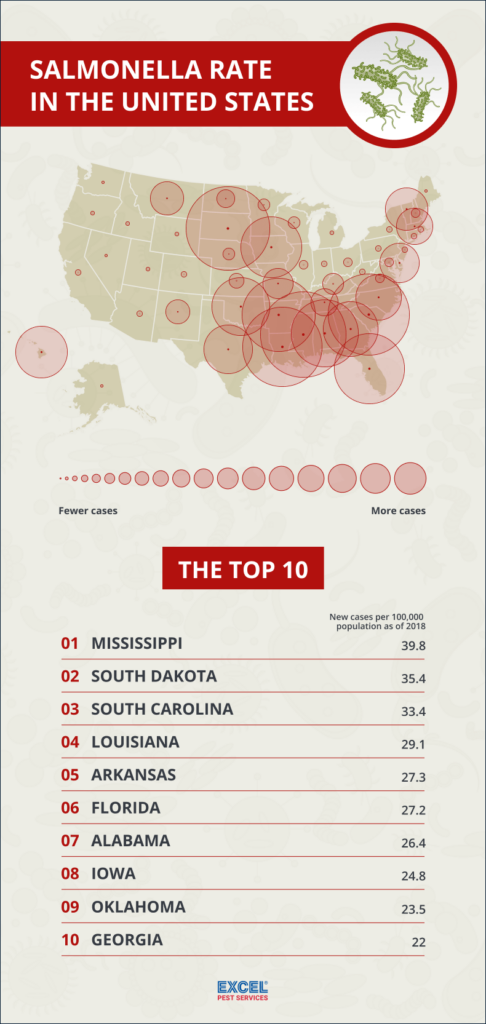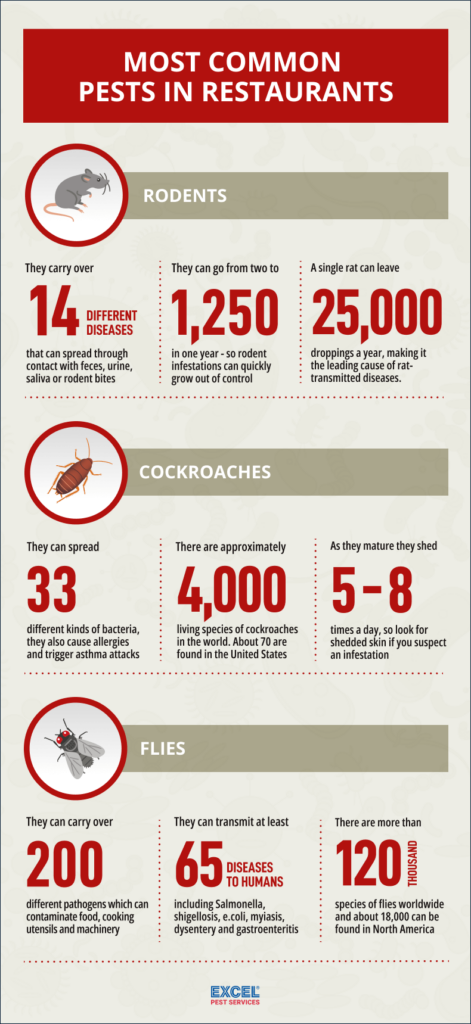

Interested in learning more about pests and the food service industry? Well, you can become an expert. With 30 years of expertise behind us, here is all you need to know about pests and restaurants.
Have a specific question? Jump to the answer:
- Signs of rodent infestation in restaurants
- Signs of cockroach infestation in restaurants
- Signs of a fly infestation in restaurants
-
Food-borne illnesses and restaurant inspections in the US
-
Food-borne illnesses and restaurant inspections in Florida
-
Food-borne illnesses and restaurant inspections in New Jersey
-
How to prevent pest infestations in restaurants
-
What is integrated pest management control?
-
How to prepare your restaurant for pest control inspection
The problem with pests in restaurants
Running any restaurant takes hard work, and in order to be successful in the food service industry, owners can quickly find themselves juggling a variety of demands that run up both time and resources. With this in mind, preventing pests in a restaurant may not be top of the priority list - but it should be.
Restaurants and other businesses in the foodservice industry have a responsibility to protect public health by preventing the contamination of food and the transmission of pest-borne diseases inside their premises. Pests not only conflict with food sanitation, they also impact the restaurant industry through replacement costs, loss of reputation and litigation from both regulatory and public authorities.
By understanding the biggest pest threats to restaurants, owners are able to take a proactive approach to pest control, protecting the restaurant's reputation, employees, customers and the industry at large.
Common types of pests in restaurants
-
Rodents in restaurants
Rats and mice are major players in the urban pest category and are one of the most common pests found in restaurants, commercial kitchens and related food service businesses. As they are attracted to frequent food supplies, of course, rodents are of major concern in the restaurant industry. Rats and mice cause some of the more unpleasant infestations. This is because their numbers can multiply rapidly.
These small creatures can cause big damage to both electrical equipment and building fixtures due to their burrowing, gnawing and nesting behaviors. They can also cause loss of stock by eating food items and damaging containers and packaging. Rodents are also known for spreading a range of diseases including Salmonellosis which can spread to food items and equipment through droppings and urine. In fact, according to the CDC, rodents in the US carry 14 different diseases (and that’s not counting the diseases they carry indirectly.) These diseases can spread to people directly through the handling of rodents; contact with rodent feces, urine, or saliva (often through contaminated food) or, if you’re really unlucky, rodent bites. Rodents can also carry an array of ticks, mites, or fleas that can act as vectors to spread diseases to humans.
Preventative rodent control measures should be in place in restaurants and should include eliminating harbourage areas in and around the restaurant and storing stock and food in airtight containers to prevent rodents from accessing supplies. Preventing access points to your restaurant is also effective, this can be achieved through regular pest inspections and building maintenance.
-
Cockroaches in restaurants
Cockroaches are the most common crawling insects that infest restaurants and related food-handling organizations. The little creepy crawlies are a significant problem due to their size - as they can hide in small places and go unnoticed. They also have quite a varied diet (they are not picky eaters), reproduce quickly and carry diseases. As they are also nocturnal, they are barely noticed in daylight and they shelter in dark places such as drains, sewers, inside equipment and in furnishings. These tiny places are hard to reach using basic sanitation and cleaning methods - so it’s important to go the extra mile.
The concern with cockroaches is that they pose a massive food safety risk. They carry a large number of disease-causing bacteria such as E.coli and Salmonella. They can easily contaminate food, packaging, cooking utensils and machinery through their droppings, saliva and urine. And to top it off - they can trigger asthma attacks in both staff and diners due to their skin and droppings that contain allergens.
Strong sanitation practices can help prevent cockroach infestations and will help you pick up the presence of cockroaches in a restaurant. Make sure to store food in airtight containers and maintain drainage to ensure effective preventative measures and pest management.
-
Flies in restaurants
There is nothing more frustrating than sitting down for your meal, only to see a fly buzzing around your food. There are a number of fly species that are attracted to food smells generated by restaurants such as fruit flies, house flies and drain flies. However, they all pose the same risk to food safety.
There are numerous fly-borne illnesses and due to their breeding habits and feeding habits, they pose a massive risk to the foodservice industry. These annoying little insects carry over 200 different pathogens - and this can lead to massive food contamination as well as contamination of cooking utensils and machinery. Flies can transmit at least 65 diseases to humans, including typhoid fever, dysentery, cholera, poliomyelitis, yaws, anthrax, tularemia, leprosy and tuberculosis - putting staff and diners at risk.
Prevention measures are vital in keeping restaurants safe from these tiny terrors. By ensuring a high standard of hygiene, you are able to reduce the appeal of your restaurant and flies may look for a different spot to frequent. Also try to keep doors and windows shut or install fly screens. Make sure that drains are clean from debris and put effective waste disposal measures in place.

Diseases spread by pests in restaurants
-
Diseases spread by rodents
Certain diseases can quickly spread from rodents to people through direct contact with infected rodents. This includes breathing contaminated air, touching contaminated materials (food utensils), eating food contaminated by an infected rodent or of course, being bitten or scratched by a rodent.
According to the CDC, the diseases spread by rodents include:
- Hantavirus
- Hantavirus Pulmonary Syndrome
- Hemorrhagic Fever with Renal Syndrome
- Lassa Fever
- Leptospirosis
- Lujo Hemorrhagic Fever
- Lymphocytic Choriomeningitis (LCM)
- Monkeypox
- Omsk Hemorrhagic Fever
- Rat-Bite Fever
- Salmonellosis
- South American Arenaviruses (Argentine hemorrhagic fever, Bolivian hemorrhagic fever, Chapare Hemorrhagic Fever, Sabiá-associated hemorrhagic fever, and Venezuelan hemorrhagic fever)
- Sylvatic Typhus
- Tularemia
A lot, right? And that's not to mention the diseases spread indirectly by rodents…
There are a variety of rodent species and all carry diseases but if you are interested in identifying the particular rodent that is bothering your establishment, take a look at our rodent identification guide.
-
Diseases spread by cockroaches
Just like rodents, cockroaches can make you very ill and the most common ways of contracting a disease carried by a cockroach is by drinking or eating something that a cockroach has directly contaminated, eating something that has been made using contaminated equipment or utensils or simply eating or drinking something that touched a contaminated surface. This contamination occurs when infectious particles have been picked up on the outside of the cockroach's body and have been transferred through saliva or feces.
These creepy crawlies have been proven to cause the following illnesses:
- Salmonella
- Diarrhea
- Dysentery
- Cholera
- Leprosy
- Plague
- Typhoid fever
- Viral diseases such as poliomyelitis (polio).
You heard that right - the plague and leprosy!
And if all of the above illnesses don’t make you want to take every preventive measure when it comes to cockroaches in your restaurant, they also carry the eggs of parasitic worms and have been known to cause allergic reactions in people, including asthma attacks, dermatitis and itching.
There are a variety of cockroach species and all carry diseases but if you are interested in identifying the particular cockroach that is bothering your establishment, take a look at this guide to Florida Cockroach Species by Excel Pest Services.
-
Diseases spread by flies
Listen up! Unlike other restaurant pests, flies only feed on liquid or semi-liquid substances. So, everytime they eat, the buzzing pests will regurgitate a liquid consisting of saliva and digestive juices which breaks down the food into a liquid substance, allowing them to dine. Due to this, any microorganism that may be living in their esophagus will be immediately transmitted to the item they are consuming - the item a diner is consuming in a restaurant.
Flies can also transmit pathogens physically, so when a fly lands on a human food product or any other related item, any pathogen they are carrying can easily be transmitted to where it lands.
Flies carry a variety of diseases that can be passed on to humans including:
- Salmonella
- Shigellosis
- E.Coli
- Cryptosporidium
- Myiasis
- Dysentery
- Gastroenteritis
There are a variety of fly species and all carry diseases but if you are interested in identifying the particular fly bothering your establishment, take a look at our guide on identifying different types of flies and take control of your pest management today.
Signs of pest infestations in a restaurant
-
Signs of rodent infestation in restaurants
Rodents usually take up living in food storage areas and even in ovens and kitchen equipment. They can also be found in supply closets, delivery areas, trash disposal areas, garbage cans and delivery areas. So, make sure to take preventive measures by always fully checking these spaces and keeping them as sanatizes as possible.
Some signs that point to a rodent infestation in your restaurant include:
- Damaged food packaging
- Gnaw marks on restaurant furnishings & equipment
- Droppings in pantries & other areas frequented by rodents
- Grease markings on restaurant walls
- Noises indicating rodent activity
- The presence of indoor nests
-
Signs of cockroach infestation in restaurants
Cockroaches are attracted to any kind of food available on a property - and this is why they love restaurants. They are also interesting creatures in that they will eat anything - from paper and packaging to fabrics and food. So nothing is safe when cockroaches infest! As cockroaches are small and hide easily, you may not notice them until it's too late. They are also nocturnal creatures so you won't be able to see them during the day. This is why it's important to put strong preventive measures in place - as they say, prevention is better than cure!
Some signs that point to an infestation in your restaurant include:
- Droppings that are black and no less than 1mm wide
- Brown and irregular shaped smear marks on horizontal surfaces
- Look for evidence of shedded cockroach skin - they shed 5-8 times a day as they mature into adults
- A musty and lingering odor on items in your restaurant
-
Signs of a fly infestation in restaurants
This may seem obvious because flies are very noticeable however, one or two flies now and again may appear harmless but they could turn into hundreds in a few days time. Flies breed quickly - laying up to 900 eggs at a time! This is why a fly infestation seems to happen overnight in restaurants. So, what are the warning signs?
Some signs that point to a fly infestation in your restaurant include:
- Finding maggots in or around your restaurant bins or other deteriorating matter indicates a potential breeding site.
- Is it getting warmer and you’ve seen a few more flies than usual? A flies' life cycle actually speeds up as temperatures rise - which means it can reach adulthood quicker. If you notice more flies in hot weather - they may be breeding in or near your restaurant
- Tiny dark clusters of spots that are the size of a pinhead are a big sign to look out for. These can be found in light fittings, the roof of a room, and on wall surfaces. They are also found near drains. And these are clusters of young flies waiting to reach adulthood! If you see these, you’re staring an infestation in the face!
Food-borne illnesses and restaurant inspections in the US
Restaurants, commercial kitchens, and many other businesses in the food industry have a huge responsibility for protecting the health of the public. They have to make sure the food and ingredients used are not contaminated by pests and pest-borne diseases. Plus, the legislation specifically outlines that businesses that do a lot of food handling must proactively take anti-pest measures to keep products safe for consumption.
When pests gain access to restaurants, it is easy to see why it can quickly become a massive problem for businesses. They can burrow into packaging and contaminate it, render contents inedible causing financial setbacks and of course, they can spread disease to patrons and staff. Pests can spread a variety of diseases through their fur, feet, droppings, urine and saliva - and one of the harmful bacterias all of the abovementioned pests can carry is salmonella.

Salmonellosis, an infection caused by Salmonella, usually lasts between 4 to 7 days and generally patients recover without any treatment. Salmonella can be transferred from animal products to humans so the best preventative measures are to cook food such as poultry, ground beef, and eggs thoroughly; however, pests play a massive role in the spread of this bacteria. Salmonella from pests can also lead to other illnesses such as typhoid fever, paratyphoid fever, and food poisoning.
If a restaurant experiences an infestation and one pest carries the bacteria, it can inevitably cause illness and food poisoning in those who consume affected food. Based on data from 2018, Salmonella was rampant in the US and across all states. The rate of salmonella was the 2nd highest in South Dakota, with 35.4 new cases per 100,000 population. This number was only topped by Mississippi with 39.8 new cases per 100,000 population. Nevada, Alaska and Maine saw the lowest number of salmonella cases, with 6.8, 9.0 and 9.2 new cases per 100, 000 of the population respectively. In total, there were 16.7 cases of salmonellosis per every 100,000 population in the United States.
To look out for the well-being of patrons and staff, the Food Safety and Inspection Service (FSIS) of the US set out to ensure all restaurants are up to code. The FSIS generally turns to the health department of the state, city, or county to inspect food service establishments and each state makes its own rules, often based on the Food and Drug Administration's (FDA) retail model Food Code.
Food-borne illnesses and restaurant inspections in Florida
The Sunshine State is home to more than its fair share of cockroaches, in fact, according to the US Department of Housing and Urban Development (HUD), South and Southwestern Florida have some of the densest roach populations in the entire country. There are also 23 living rodent species in Florida while the Florida heat attracts flies in droves. Flies usually begin infesting Florida in the Middle of July - and this has come to be known as fly season.
With the heat, humidity and climate, Florida restaurants can quickly become a breeding ground for pests. The Department of Business and Professional Regulation inspects most restaurants in Florida and Florida restaurants usually receive 2 unannounced inspections every year.
However, if the DBPR receives a complaint, an inspector will be sent and restaurants with a strong history of non-compliance will be inspected three times a year. But restaurants with a history of food-borne illnesses will be inspected up to 4 times a year - and the most common cause for food-borne illnesses is of course, pests.
Pests can spread diseases through their fur, feet, droppings, urine and saliva, as well as harmful bacteria like salmonella, if they are carrying it. This can inevitably cause illness and food poisoning in those who consume affected food, specifically in restaurants. And in 2018, Florida was the state with the 6th highest number of reported salmonella cases, with 27.2 new cases per 100,000 population. The state with the highest number of reported salmonella cases that same year was Mississippi, with 39.8 new cases per 100,000 population.
Food-borne illnesses and restaurant inspections in New Jersey
Rodents are common in New Jersey as these little creatures thrive in densely populated areas, and as New Jersey is the most densely populated state in the US, it makes sense for rodents to cause extensive problems on New Jersey properties and restaurants. Cockroaches are also commonplace in the state, with seven different cockroach species calling the Garden State home. Flies also become very active in New Jersey once the weather starts to warm up and the spring and summer time are the typical seasons where flies start to become massive pests in the state.
As New Jersey is the most densely populated state in the US, pests become drawn to it and can become a significant problem in homes and of course, restaurants. In New Jersey, county or municipal health departments are required to conduct annual inspections at all establishments serving food. These surprise inspections cover all aspects of eatery operations, from cleanliness to proper storage of foods to avoid pests and food-borne illnesses.
Restaurants in New Jersey can earn one of three grades in these surprise inspections, these being:
- S - Satisfactory: The establishment is found to be operating in substantial compliance.
- C - Conditionally Satisfactory: The establishment was in violation of one or more of the New Jersey State Sanitary Codes, Chapter 24 (which deals with retail food establishments and vending machines) and a re-inspection is warranted.
- U - Unsatisfactory: Unsanitary or unsafe conditions result in a temporary closure of the establishment.
New Jersey counties are taking this a step further and are now offering real time reporting on restaurant grades. Gloucester County of New Jersey is leading the way, providing patrons with the most recent grade online, along with date of inspection. These listings are updated monthly as inspections are completed. With strict and transparent restaurant inspections on the up-and-up in the state, it’s no wonder New Jersey had one of the lower salmonella rates in the US in 2018, with 11.7 new cases per 100 000 population.

How to prevent pest infestations in restaurants
- Regular deep cleans: One of the most effective ways to avoid a pest infestation is to carry out deep cleans and regular inspections - especially in pest hotspots such as your restaurant dining area, window sills, equipment and trash cans. As part of your regular inspection, analyze site usage and determine the areas that require more frequent cleaning and introduce a cleaning rota that is completed every day.
- Strict food storage: Avoid new pests taking up space in your restaurant by having dedicated food storage areas. Use airtight containers to keep pests out and keep harmful bacteria from growing. Make sure to store all food off the floor and on a surface that is far from any ground pests.
- Install fly screens: Mesh screens are an effective way to avoid a fly infestation. These can be installed on windows and doors - this means that when you need to leave the windows open on warmer days - flies and other flying insects won’t be able to get in easily.
- Dedicated food preparation areas: Food preparation is a hotspot for pests. In order to avoid attracting pests to this sare, ensure that food is prepared in a dedicated preparation area, reducing the possibility of debris being passed around different areas of the restaurant. Also ensure that the area is cleaned deeply and regularly before, during and after a shift. All food in the area should be disposed of in trash cans that are properly sealed.
- Proper waste control protocols: Waste is one of the primary causes of pest problems in restaurants and in order to keep them clear of pests, use a dedicated waste storage area as well as separate bins for items such as packaging and food leftovers. Also make sure that all trash bins inside are taken outside at the end of the shift. Make sure that all bins are properly sealed.
- Eliminate all possible entry points: Fix foundation cracks, replace missing shingles, seal holes in walls with caulk or steel wool, close any gaps around doors and windows, and place covers over vents and chimneys.
- Regular pest control inspections: Pest management is of the utmost importance in the food service industry. Infestations jeopardize your hard-earned reputation and, more importantly, put the health and safety of your customers and employees at risk.
Sound overwhelming - well this is where Integrated Pest Management control comes into play!
What is integrated pest management control?
Integrated Pest Management makes pest control easy, so you can be confident that your establishment remains pest-free and safe.
Integrated Pest Management, or IPM, is an environmentally-friendly and risk-averse approach to pest control. The aim of IPM is to eradicate pests while limiting pesticide use and posing the least possible danger to people, pets, property, and the environment. It utilizes the most up-to-date scientific knowledge about pests and how they interact with their surroundings. This information is used in conjunction with common-sense practices to provide the most economically effective and least hazardous pest management possible. IPM eliminates the pests as well as the environmental conditions that allow them to thrive.
By working with an experienced pest control company, an IPM plan can be built specifically for your restaurant. Each IPM plan is built specifically to target only the pests it is meant to eliminate. By using pest-specific methods, all unnecessary pesticide use is eliminated and the vermin are taken care of with the least possible disruption to your business. IPM is, as its name implies, integrated into the day-to-day goings on of your establishment.
Wondering if there’s a pest control service plan that will work for you? Give Excel a call today to schedule a free inspection. Excel works with you to build a pest management plan that is tailored to your establishment’s unique set of needs, and scheduled to avoid interrupting your business’s daily happenings. With your custom-built IPM plan, pests won’t stand a chance.
How to prepare your restaurant for pest control inspection
With strict health codes to abide by, a single pest or a few insects could cost you customers and even your business. This is why it’s important you call in the experts to inspect your restaurant, prevent pests and remove any possible pest infestations from the vicinity.
Below, we take a look at how you can prep your restaurant for pest control services.
Make your Restaurant Accessible
- Make sure your pest control company has access to all areas of your restaurant. This includes offices, break rooms, garbage areas, locker rooms and storage areas
- Ask staff to place personal items away in lockers or take them home for the inspection
Prep the Bar Area
- Clean your entire bar area. This includes equipment and all areas below the bar
- Put all garnishes and foods away
- Remove all bottles, condiments, utensils glassware and dishware and place them on the top of the bar and cover these items with sheets, garbage bags or plastic
- Cover all beer taps and cover any open nozzles and ice bins
Prep the Dining Area
- Clean the entire area, from under the tables and booths to all surfaces of the wait stations
- Pull up all booth seats
- Remove any items that are being stored below seats and tables
- Move all dishware, menus, silverware, table cloths and holders and place them on one countertop or table
- Cover all of these items with plastic wrap, garbage bags or plastic sheets
Prep the Kitchen
- Make sure to put away all ingredients and foods
- Clean the kitchen area thoroughly including behind the counter and under all equipment
- If possible, move equipment 18 - 24 inches away from the wall. This includes shelves and storage racks
- As with all other areas, remove all condiments, silverware, dishware and utensils and move them to a single countertop
- Remove all items from wheeled carts and place them on the same countertop
- Cover all items on the countertop with plastic wrap, garbage bags or plastic sheets
- Make sure to cover all items on shelving that have been moved from the wall. This includes the bottom of the items as well.
- Cover metal trays and fryers - and make sure that there is no oil exposed
- Cover ice bins or empty ice bins
- Cover all drink dispensers






